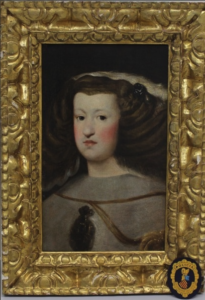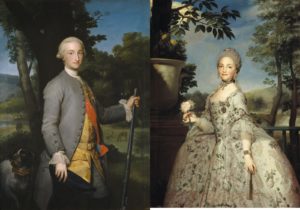
Portrait of Mariana of Austria, offered as the work of Diego Velázquez (courtesy of the Policía de la Generalitat)
In Spain, the Historic Heritage division of Valencia’s regional police seized five paintings said to be forgeries being passed off as originals by the Spanish masters Diego Velázquez and Francisco de Goya. The suspects involved attempted to sell the works for €76 million (or $84 million). The paintings came to the attention of investigators after the owners approached several prospective buyers in the cities of Valencia and Castellón. While a story like this often includes loads of forensic content, with scientists analyzing pigment samples, brushstroke patterns, and provenance documents, none of that was necessary. In what might be one of the laziest examples of art forgery I’ve ever heard, whoever created these paintings simply copied well-known portraits currently hanging in major museums today.
Art forgery is one of the lucrative criminal undertakings in Spain, often named in the same breath as the drug trade, weapons trafficking, and prostitution. I’ve previously written about confiscated forgeries and counterfeit rings broken up by Spanish authorities. Spain is a country that places an immense amount of pride in its national heritage and dedicates large amounts of government resources to trying to protect it. This fact, therefore, makes these forgeries all the more baffling. Even without doing too much work, a casual viewer might recognize one of the forgeries as a portrait of Mariana of Austria, wife of King Philip IV, which now hangs at the Palace of Versailles. The fake is a bust-length cropped version of the original that cuts out her dress’s distinctive pannier hoop skirt. Velázquez executed the original work around 1660 when the queen was 26-years-old. Though the 1660 portrait is not as iconic as Velázquez’s full-length 1653 portrait that now hangs at the Prado Museum, the queen’s stoic expression, rosy cheeks, and wide, braided hairstyle are equally as distinctive as the queen’s dress. The suspects were asking for €50 million just for the Mariana portrait.

The original 1765 portraits of the prince and princess of Asturias, future King Charles IV and Queen María Luisa by Anton Raphael Mengs
The scammers passed off the other four works as originals by Francisco de Goya, who initially established himself as a painter for the court of King Charles IV. Portraits of Charles IV and his wife María Luisa of Parma were among the seized paintings. There were just a few problems with them, though. Like the Mariana portrait, these two are nothing but cropped, bust-length copies of the original, full-length paintings, both of which hang in the Prado. More importantly, however, is that the original paintings are not by Goya at all. Rather, they are by the German artist Anton Raphael Mengs, which he created in 1765, the year of the couple’s marriage. Each copy was offered at €7 million. The remaining two fake Goya paintings are a pair of religious scenes. The Blessing of Santa Rosa de Lima, with an asking price of €8 million, is less in Goya’s style and more characteristic of Italian painters active in the century before Goya’s birth. Then, specialists doubt that a trained artist created Allegory of the Pillar of Zaragoza.
These seized forgeries will be displayed at the Valencia Museum of the Enlightenment and Modernity as part of an ongoing exhibition about confiscated counterfeit artworks. Spanish authorities are still in the middle of investigations and have not made any arrests yet. Valencian police will likely charge the four suspects with fraud concerning the paintings and their falsified provenance documents.
